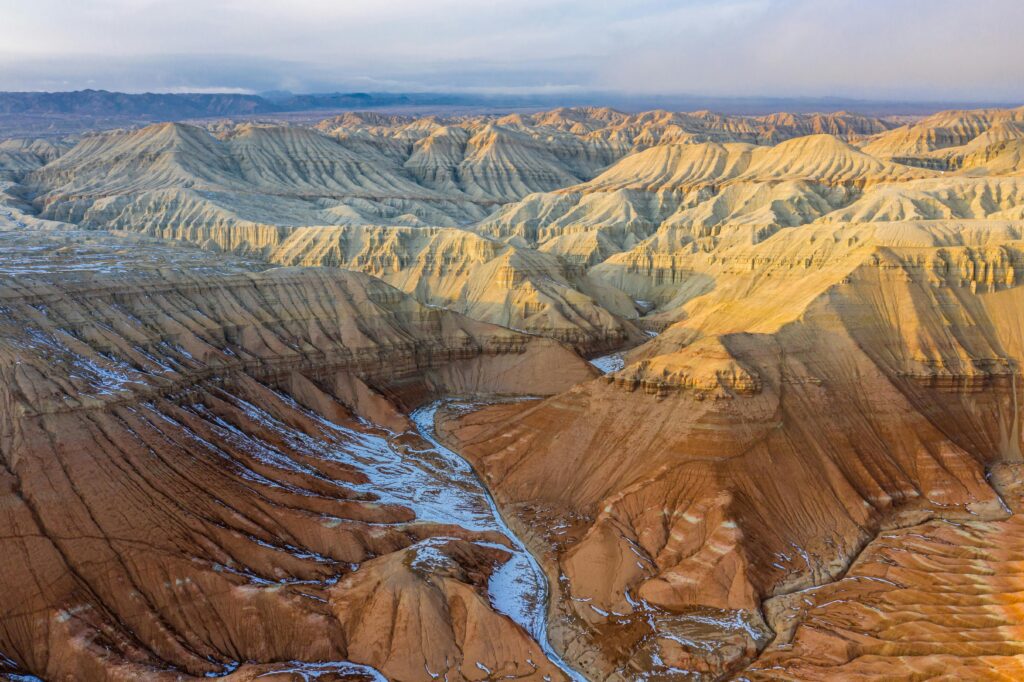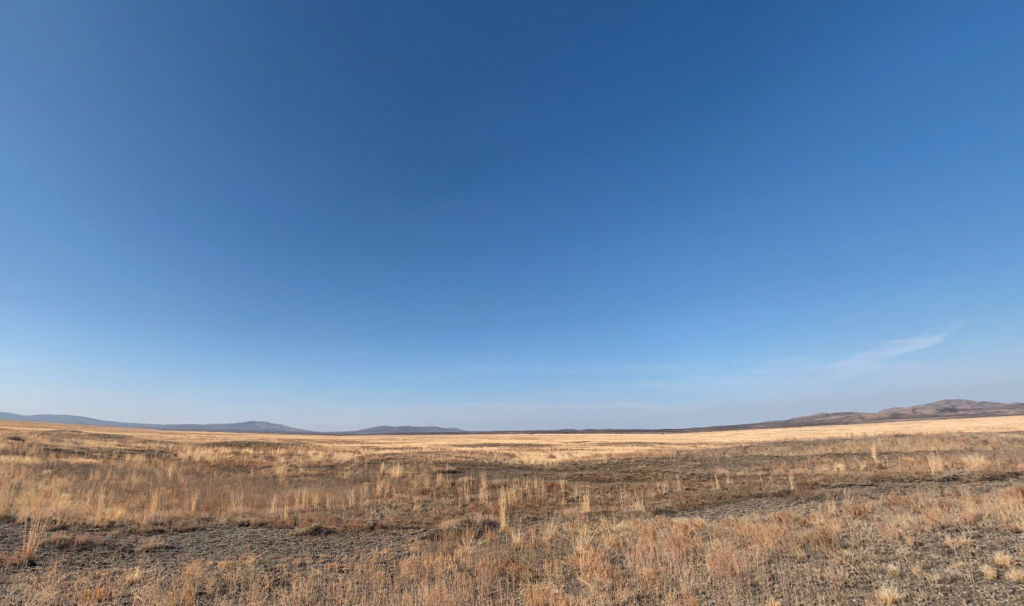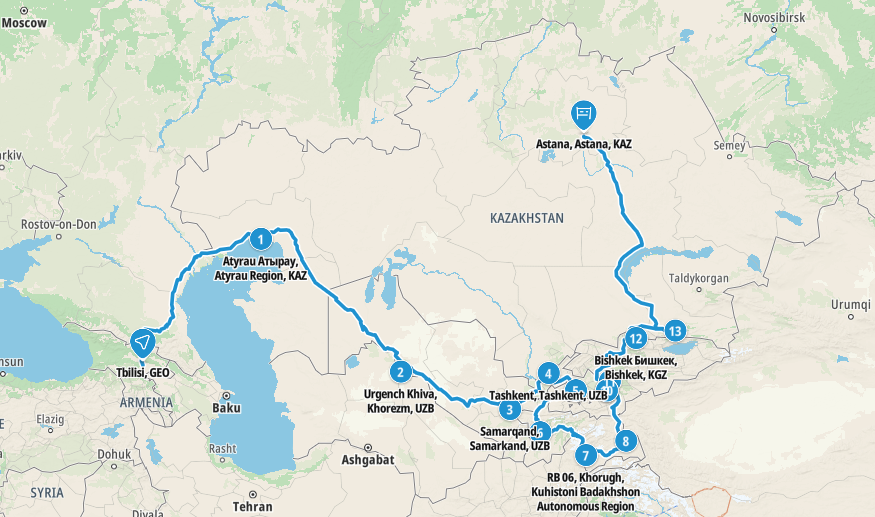Kazakhstan / Қазақстан Республикасы / Республика Казахстан – Let’s explore here
What’s it like in Kazakhstan?
Kazakhstan is a transcontinental country – it is located both in Europe and in Asia. Because of this, the information is located both in our European and in our Asian travel destination sections. Don’t worry though, all the information for this amazing country is captured on this page.
Kazakhstan is the largest landlocked country in the world, and the ninth largest overall. It’s massive to travel across – don’t underestimate the time it takes, and plan where you might want to stay. Because of its size, it’s one of the least densely populated places on the planet – having only 18 people per square mile (c.f. 720 people per square mile in the UK).
More than three quarters of Kazakhstan is desert, and the highest point is Khan Tengri in the south east of the country, on the order with China and Kyrgyzstan, at 23,000 ft (7,010m) above sea level. Kazakhstan’s neighbours are China, Kyrgyzstan, Russia, Turkmenistan and Uzbekistan.
The population of Kazakhstan is around 20 million people (2024), about 1½ million of whom live in the metropolitan area of the capital, Astana. It relies heavily on its oil, minerals and metals reserves.


A bit about the history of Kazakhstan
Early History and Nomadic Cultures
Kazakhstan’s history dates back to ancient times, with its territory being home to various nomadic tribes. The region was inhabited by the Scythians and Sakas in the early centuries BC. Over time, it became a major center for nomadic empires, with various tribes such as the Huns, Turks and Mongols passing through or establishing control.
The Mongol Empire
In the 13th century, Kazakhstan became part of the Mongol Empire, under the leadership of Genghis Khan. After Genghis Khan’s death, the territory became part of the Golden Horde, a Mongol state. The Mongol influence on the region continued for several centuries.
Kazakh Khanate and Early Modern Period
By the 15th century, the Kazakh Khanate was formed, uniting various Kazakh tribes under one rule. The Khanate controlled much of the territory that is now Kazakhstan, and its power fluctuated as it contended with regional powers such as the Oirat Mongols, the Russian Empire and the Uzbeks. By the 18th century, Russia began expanding into Kazakhstan, seeking to incorporate the region into its empire.
Russian Empire and Soviet Era
In the 19th century, Kazakhstan became fully integrated into the Russian Empire. The Russian imperial government introduced land reforms and attempted to suppress local nomadic cultures, encouraging settlement by Russians and other ethnic groups. The region was subjected to significant economic exploitation and social upheaval during this period.
After the Russian Revolution in 1917, Kazakhstan became part of the Soviet Union. During the Soviet era, Kazakhstan underwent significant changes, including forced collectivisation and the settlement of ethnic Russians in the region. The Soviet government also established nuclear testing sites, notably at Semipalatinsk, which led to lasting environmental and health consequences for the region.
Independence and Modern Kazakhstan
In 1991, Kazakhstan declared independence from the Soviet Union following its collapse. The country elected Nursultan Nazarbayev as its first president, who remained in power for nearly three decades. Kazakhstan pursued a policy of balancing relations with both the West and Russia, while also seeking to develop its vast natural resources, particularly in oil and gas.
Kazakhstan has also worked on its national identity, promoting the Kazakh language and cultural heritage, though it continues to be a multi-ethnic country with significant Russian-speaking populations. The country has invested heavily in infrastructure and modernisation while maintaining a stable political environment, though concerns about political freedoms and human rights remain.
Today, Kazakhstan is the largest landlocked country in the world and plays a significant role in Central Asia’s political and economic landscape. It is rich in natural resources and continues to develop as a regional power in the post-Soviet era.


Kazakhstan road trip
Depending on the outcome of the land border issue in Azerbaijan (see our blog), if the border does open, we hope to cross the Caspian Sea into Aktau, before travelling overland to Uzbekistan. Hopefully this will improve our knowledge of this intriguing and beautiful country, and enable us to meet some interesting people. We’ll be updating this page at that time – don’t forget to check back 🙂
Map of our road trip through Kazakhstan

This is a map of our planned road trip through Kazakhstan.
We’re hoping to be able to drive overland to Uzbekistan –Tajikistan – Kyrgystan, then back to Kazakhstan)
What’s it like to drive in Kazakhstan?
They drive on the right hand side of the road in Kazakhstan. In the main roads in Kazakhstan are quite poor, and there are many unsurfaced dirt tracks. Driving standards in Kazakhstan are also quite poor.
Do you require an international driving permit in Kazakhstan?
We’ve created a dedicated page to driving abroad, which answers this question, and more, which you might find helpful.
Can you use your UK driving license when driving through Kazakhstan?
We’ve created a dedicated page to driving abroad, which answers this question, and more, which you might find helpful.
Do I need a carnet de passages to drive in Kazakhstan?
We’ve created a dedicated page to driving abroad, which answers this question, and more, which you might find helpful.
What are the speed limits in Kazakhstan?
The speed limits for cars in Kazakhstan are:
- 35 mph (60 km/h) for urban driving
- 55 mph (90 km/h) outside of built up areas
- 55 mph (90 km/h) on dual carriageways
- 70 mph (110 km/h) on motorways
What currency do they use in Kazakhstan?
In Kazakhstan they use the Kazakhstani tenge. The use of credit / debit cards is now widespread, although not guaranteed – have some cash just in case, particularly in cafés and restaurants. Travellers cheques are accepted in cities. There are lots of ATMs. Dollars are also widely accepted fir larger purchases, although exchange rates are often poor.
You should make yourself aware of the amount that your bank charges you for using credit and debit cards abroad. Often credit cards are cheaper for purchasing items directly, and for withdrawing cash from ATMs.
What language do they speak in Kazakhstan?
They speak both Kazakh and Russian in Kazakhstan, although many of the population also speak English or German, particularly the younger generations, and particularly in cities.
What time zone is Kazakhstan in?
Remember, when you’re planning your next trip to take a look at what time zone it’s in.
Do I need a visa to visit Kazakhstan?
We’ve created a dedicated, more comprehensive page on visas, which you should find helpful. Check it out!
What plug / socket type do they use in Kazakhstan?
In Kazakhstan they use plug / socket types C and F.


Health issues in Kazakhstan
Is it safe to drink water in Kazakhstan?
No, it is not safe to drink tap water in Kazakhstan. Bottled water is readily available across the country.
What vaccinations are required for Kazakhstan?
This NHS website is kept up to date with all relevant information on vaccinations in Kazakhstan.
Phones in Kazakhstan
What is the country calling code for Kazakhstan?
The country calling code for Kazakhstan is +997
What are the emergency phone numbers in Kazakhstan?
The emergency number for police in Kazakhstan is: 112 / 102
In Kazakhstan, the emergency number for ambulance is: 112 / 103
The emergency number for fire in Kazakhstan is: 112 / 101
If you’ve got some useful info that you’d like to share, let us know!
And don’t forget to check out all the other pictures!
